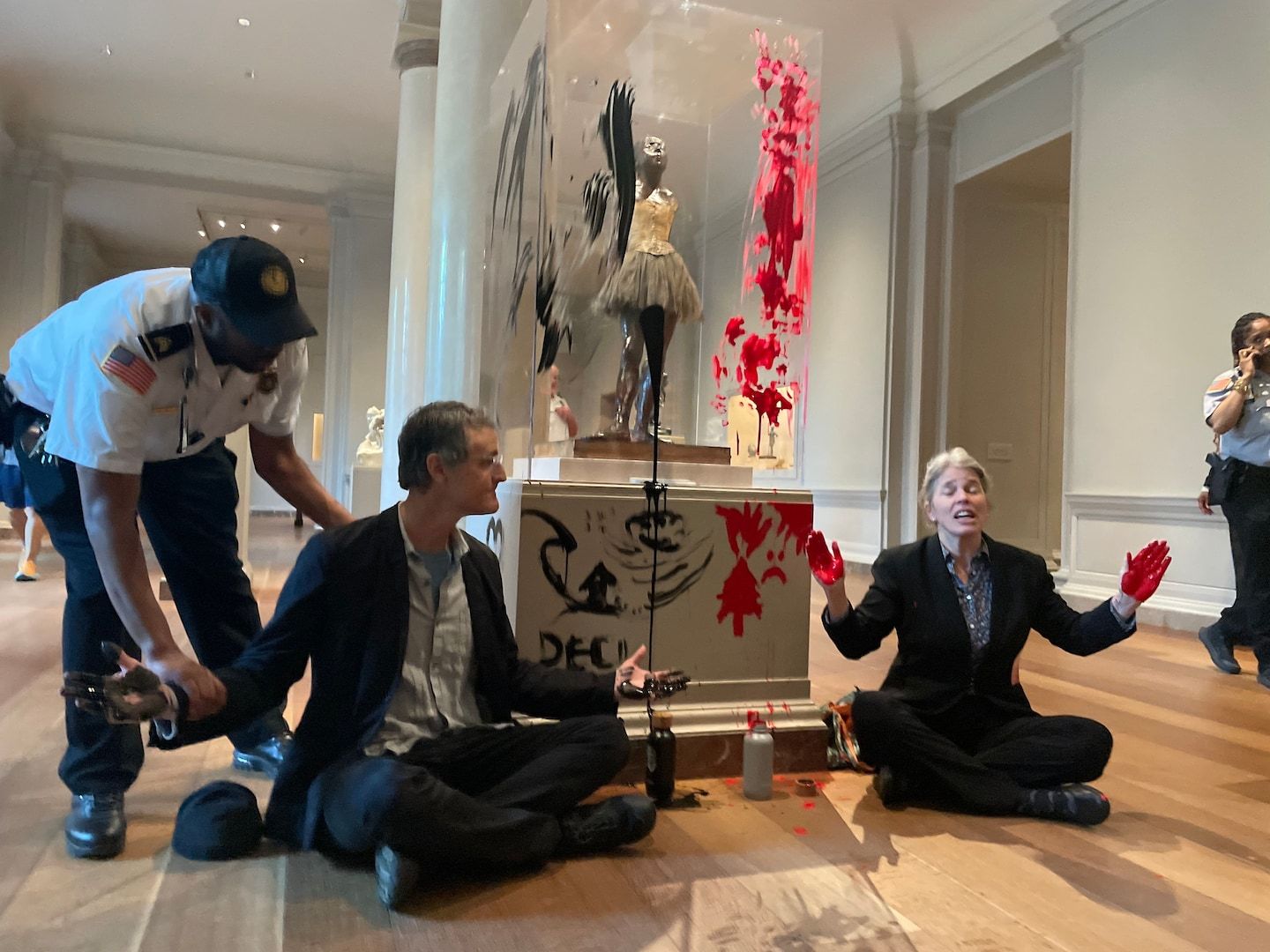Climate protesters smear paint on case housing Degas sculpture in D.C.
Listen 6 min Comment on this story Comment Gift Article Share
Protesters smeared black and red paint on the case and pedestal of Edgar Degas’s “Little Dancer Aged Fourteen” sculpture at the National Gallery of Art in D.C. on Thursday to bring attention to the climate crisis and demand that President Biden declare a climate emergency. Fast, informative and written just for locals. Get The 7 DMV newsletter in your inbox every weekday morning. ArrowRight Two members of the climate activist group Declare Emergency smeared paint on the case of the "Little Dancer Aged Fourteen" statue on April 27. (Video: John Farrell, Jackson Barton/The Washington Post) The protesters — a man and a woman, dressed in black suits — slathered their hands, then crouched down to paint the pedestal on which the ballerina sculpture is displayed. They then stood up and smeared their hands across the clear case protecting the artwork. Police removed the two people in handcuffs and ushered out the people inside the gallery.
Declare Emergency, the climate group that organized the stunt, identified the protesters as Joanna Smith, 53, of New York City and Tim Martin, 54, of Raleigh, N.C.
“The Earth is beautiful, and we’re destroying it with climate change,” Smith said as security officials asked the small crowd to back away from the sculpture.
Advertisement
Kaywin Feldman, the director of the National Gallery of Art, condemned the protest in a statement. The museum closed the gallery where “Little Dancer” was on display, as well as other connecting rooms. The museum has removed the defaced case so experts can assess the damage, and the FBI is assisting in the investigation, the statement said.
“We unequivocally denounce this physical attack on one of our works of art and will continue to share information as it becomes available,” Feldman said in the statement.
This follows protests around the world targeting galleries and museums. In Europe, climate activists threw cans of tomato soup on one of Vincent van Gogh’s most famous paintings, “Sunflowers,” in London’s National Gallery and smashed cream pie into the face of King Charles’s wax statue at Madame Tussauds in London. Activists have also flung mashed potatoes on a Claude Monet painting at the Museum Barberini in Potsdam, Germany. Climate activists glued themselves to a painting by Sandro Botticelli at the Uffizi museum in Florence and glued their hands to the frame of Pablo Picasso’s “Massacre in Korea” in Australia.
Climate activists are turning to these types of disruptive tactics because they feel the world is running out of time to curb catastrophic, irreversible warming, said Dana R. Fisher, a University of Maryland sociology professor who studies protests and social movements. She noted suffragists had slashed artwork in the past, and these recent protests target protective casings or frames as opposed to damaging the art.
Advertisement
The point, Fisher says, is to draw attention. And research shows these kinds of “radical tactics” can persuade people who are sympathetic to the climate issue to be more supportive of moderate perspectives, she said.
“This is purely performative protest. It’s disruption as shock,” Fisher said. “Nobody’s going to like these guys for throwing paint at ‘Little Dancer’ … but that’s okay. That’s not their point. If the goal here is to get general attention and to shift the conversation to focus more on climate change, there’s a lot of evidence that this is more effective.”
A recent U.N. climate report warned that the world is on track to pass a dangerous temperature threshold within the next 10 years that would result in catastrophic warming that could cause millions of people to die.
Declare Emergency, which is seeking governmental action on climate change, wrote in a news release that two demonstrators who are supporters of the climate group were arrested. The U.S. attorney’s office for D.C. could not immediately confirm the arrests or provide additional information about the incident.
Advertisement
Declare Emergency said this demonstration was part of a wave of actions to demand that Biden declare a climate emergency and halt all fossil fuel projects on federal and Indigenous lands. The group also organized demonstrations in the region that resulted in protesters being arrested for blocking traffic.
In the quiet gallery Thursday morning, Smith knelt at the base of the statue, poured red paint into her hand and began to draw what appeared to be a tree on fire. Next to her, Martin used black paint to draw a house and a cloud.
Visitors to the gallery swiveled their heads and slowly assembled around the two protesters. They took out their phones and started recording the protest.
“For our children, we are worried like most of Americans, about climate and about biodiversity crisis,” Martin said. “And we need our leaders to step up, put their differences aside and simply be responsible.”
Advertisement
Two Washington Post journalists who were covering the protest were briefly detained by law enforcement with the National Gallery of Art protection services. They were released after The Post’s counsel intervened.
Smith, according to the news release, has family members sickened by polluted air and is deeply concerned about the planet and the future.
“That is why we decided to come visit this beautiful, beloved child that the world knows,” she said, sitting in front of the artwork with her legs crossed and hands covered in red paint facing out to the small crowd. “She’s imperfect like we all are imperfect, but she’s strong and she’s not resigned to destruction.”
Morgan, 14, of New York City — whose father allowed her to speak on the condition that The Post identify her only by her first name to protect her privacy — stood among her eighth-grade classmates who were on a school trip to the nation’s capital. She wasn’t entirely sure what was happening but managed to make out that people who were “very upset” were trying to bring attention to the environment and the future for children.
Advertisement
“I think it’s good because it gets people’s attention, but I don’t think it’s good because it’s ruining property,” she said. “It made me not afraid to use my voice.”
This was the first time Judy Norinsky, 66, of Stamford, Conn., visited the National Gallery of Art — and she was shocked.
Norinsky referred to herself as a “good liberal” who wants more people to be aware that ñEarth is warming and believes the world needs to take action. But she did not approve of the act of protest that she witnessed.
“This is an important institution, and I suppose there are legitimate rights that people have, and it could be a legitimate way to protest,” Norinsky said. “But I frankly found it shocking and offensive.”
Fisher, the professor who has studied the climate movement since the 1990s, predicts the lack of significant government action and a warming planet will push protesters to take more drastic action to bring attention to the climate crisis.
“It leads to general strikes and leads to sit-ins. It leads to blockades. That’s where this is going. This is not going toward more people’s climate marches on a weekend day with a legal permit and a banner in the front,” Fisher said. “Desperation, in terms of frustration, is leading them so far to be disruptive but still completely nonviolent.”
GiftOutline Gift Article
Source: The Washington Post


